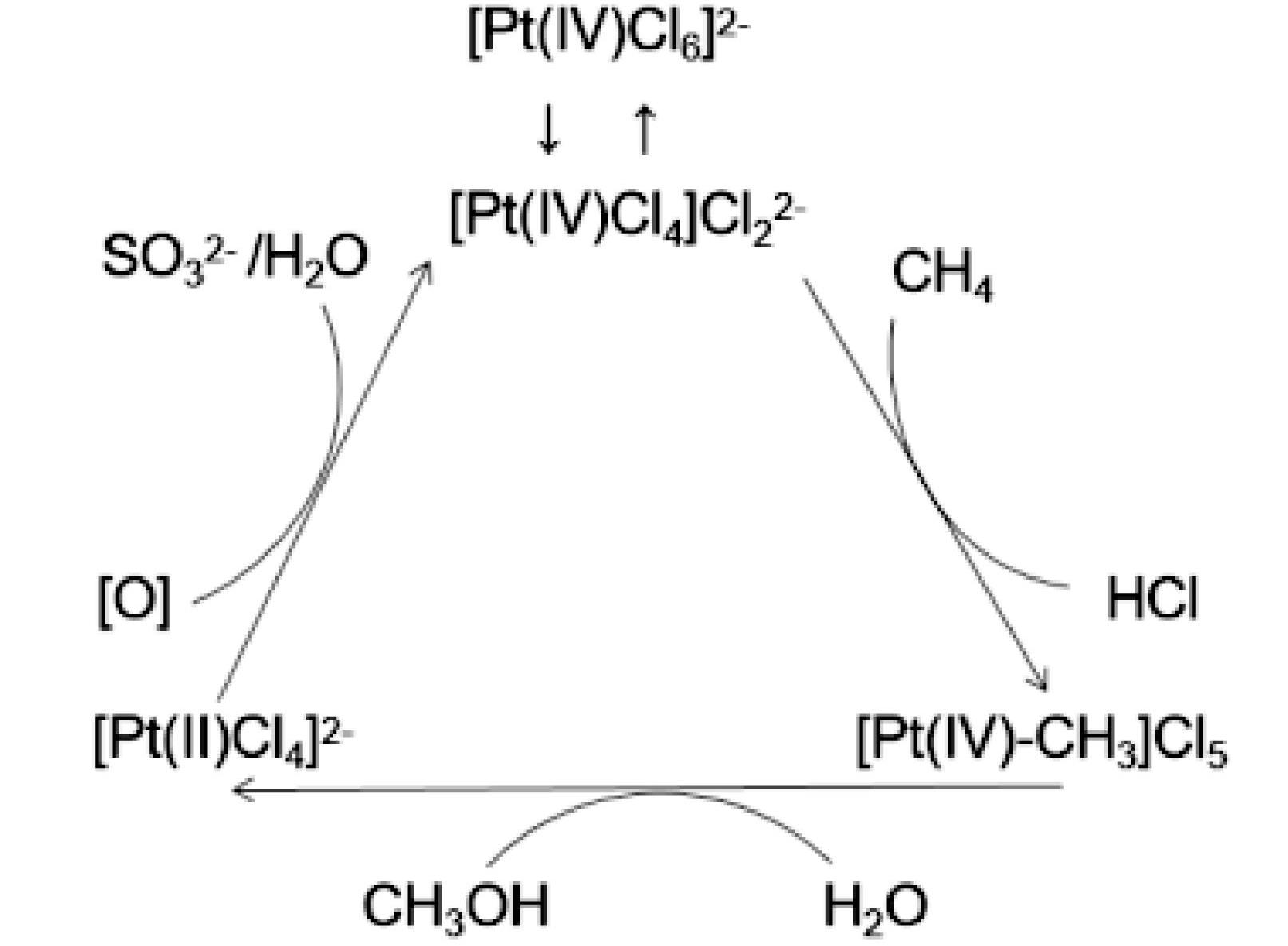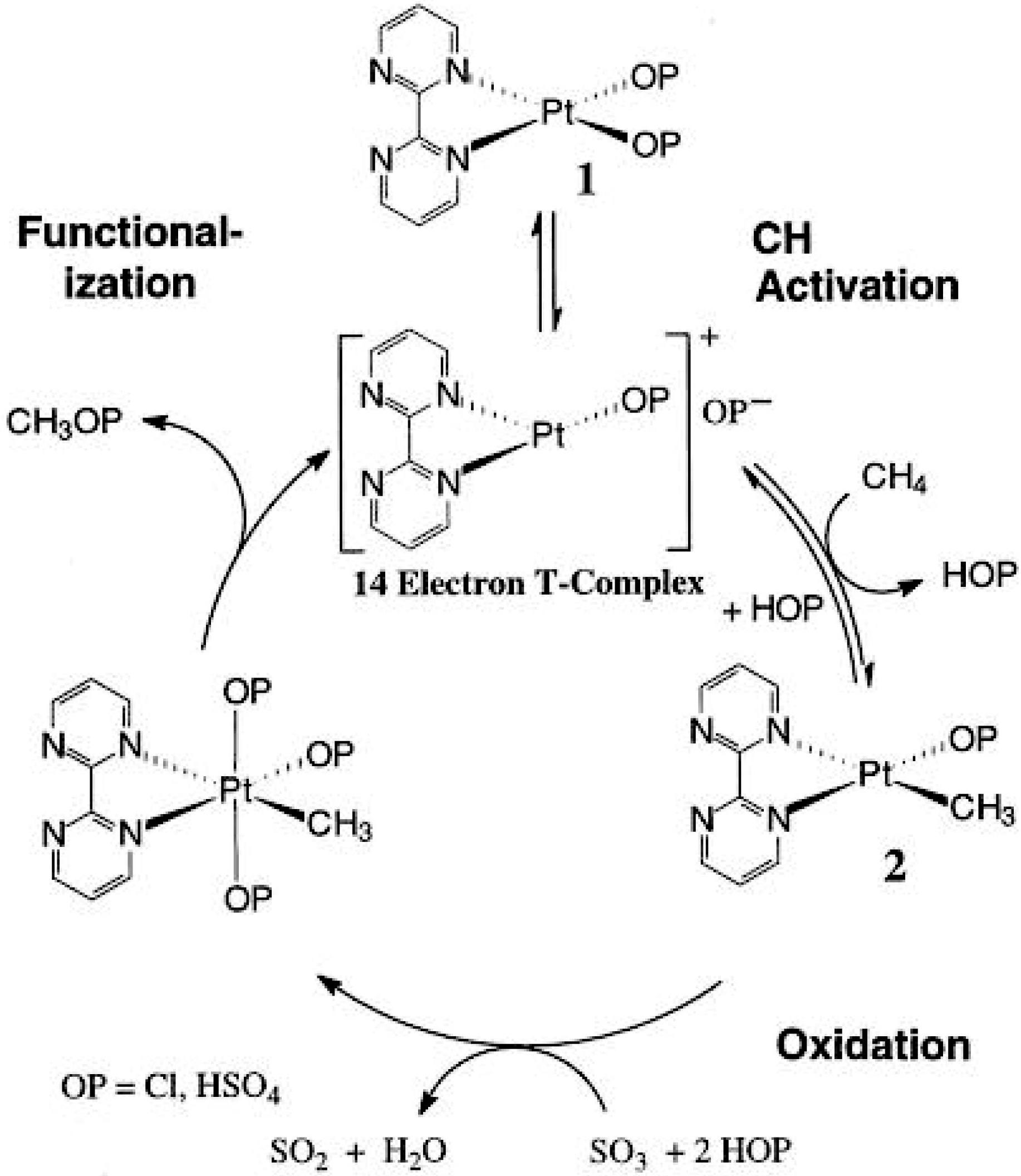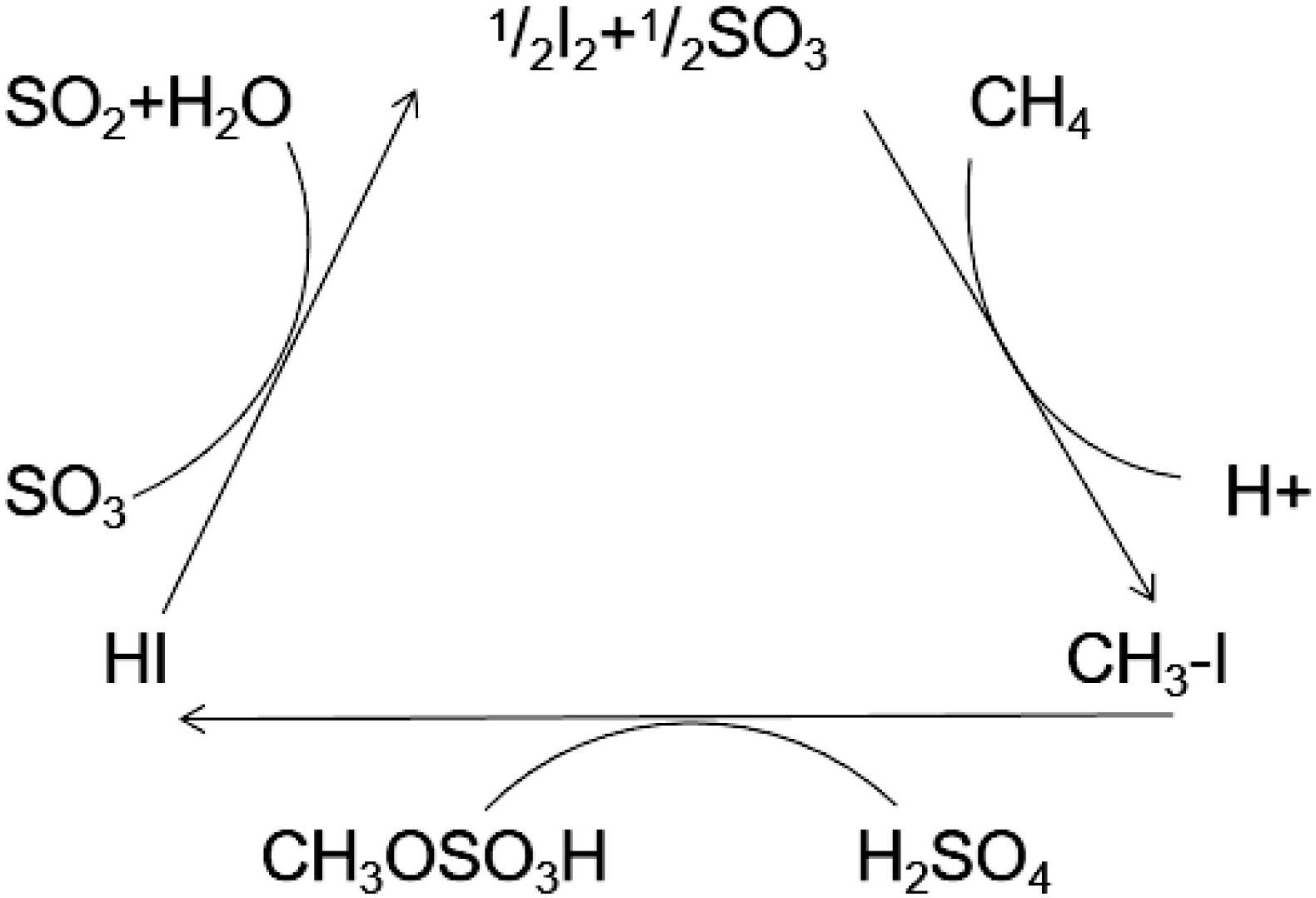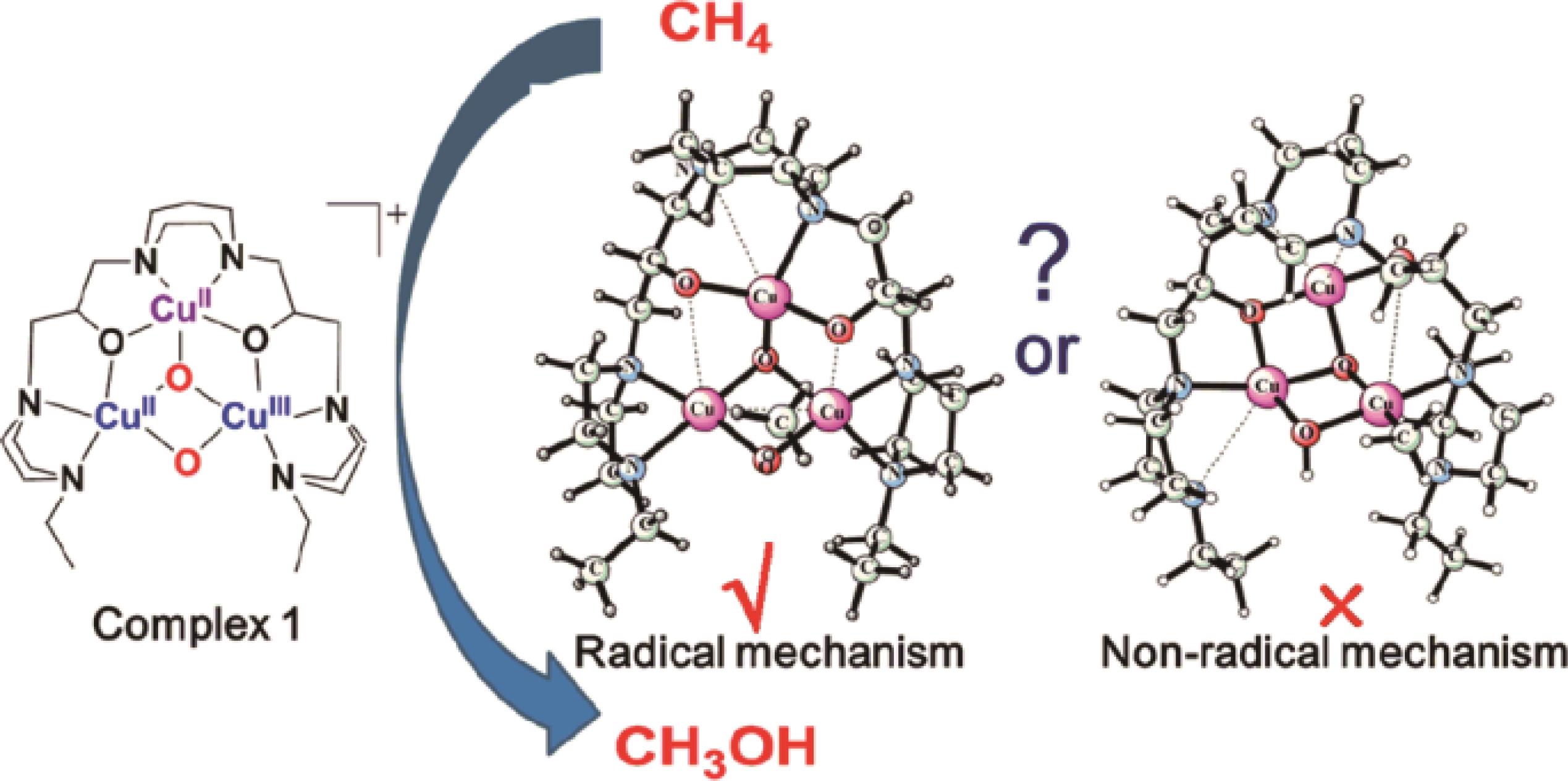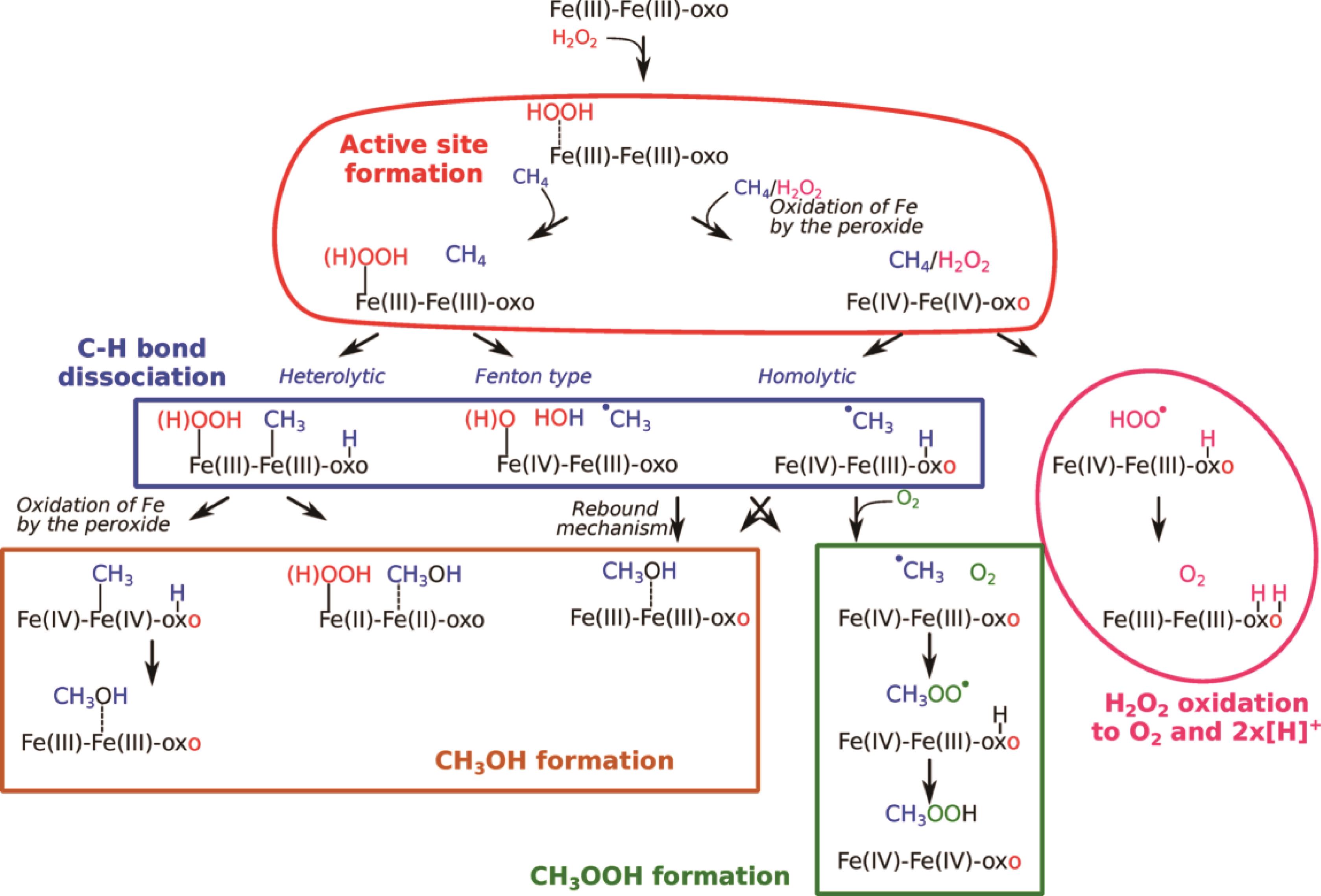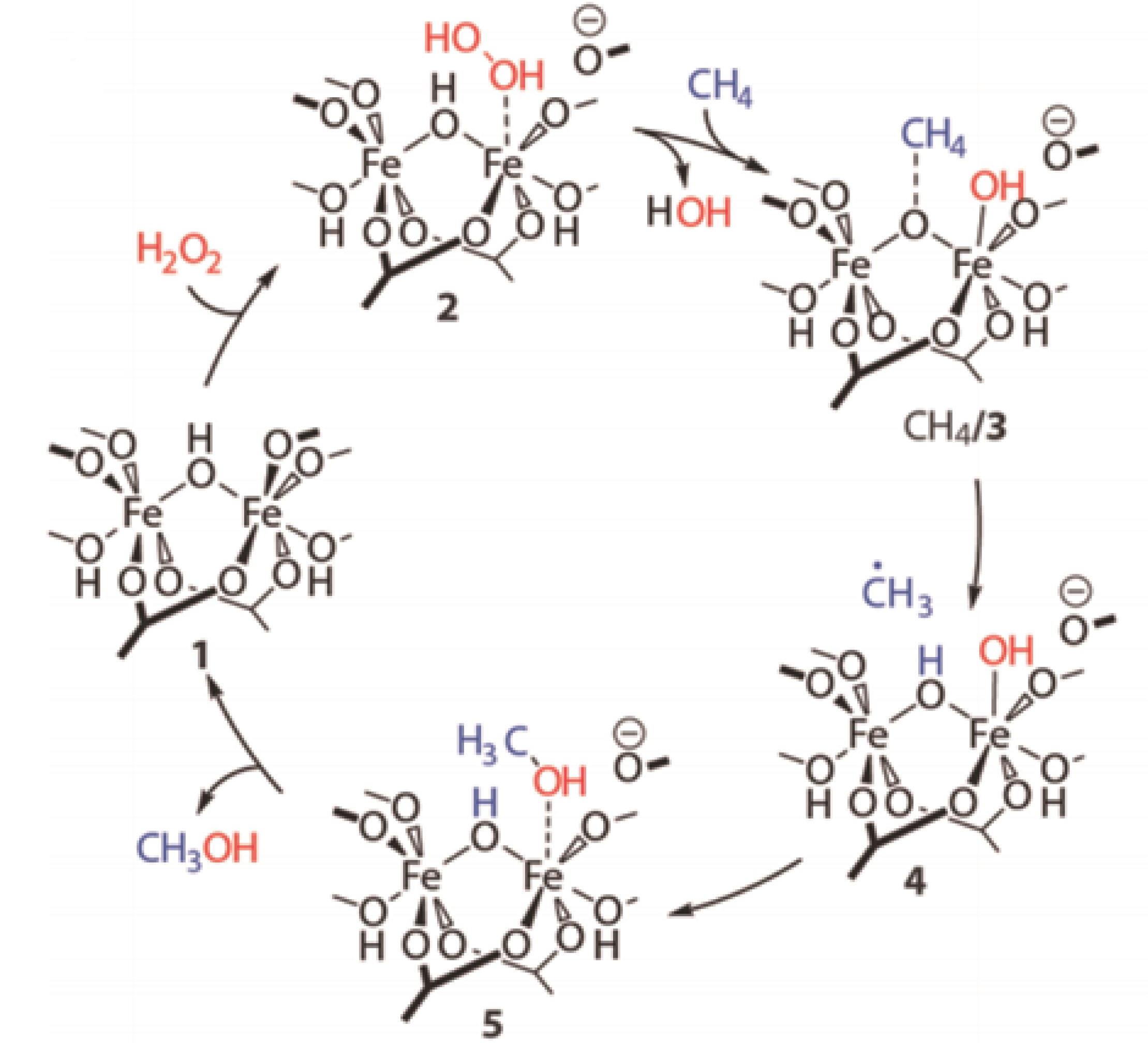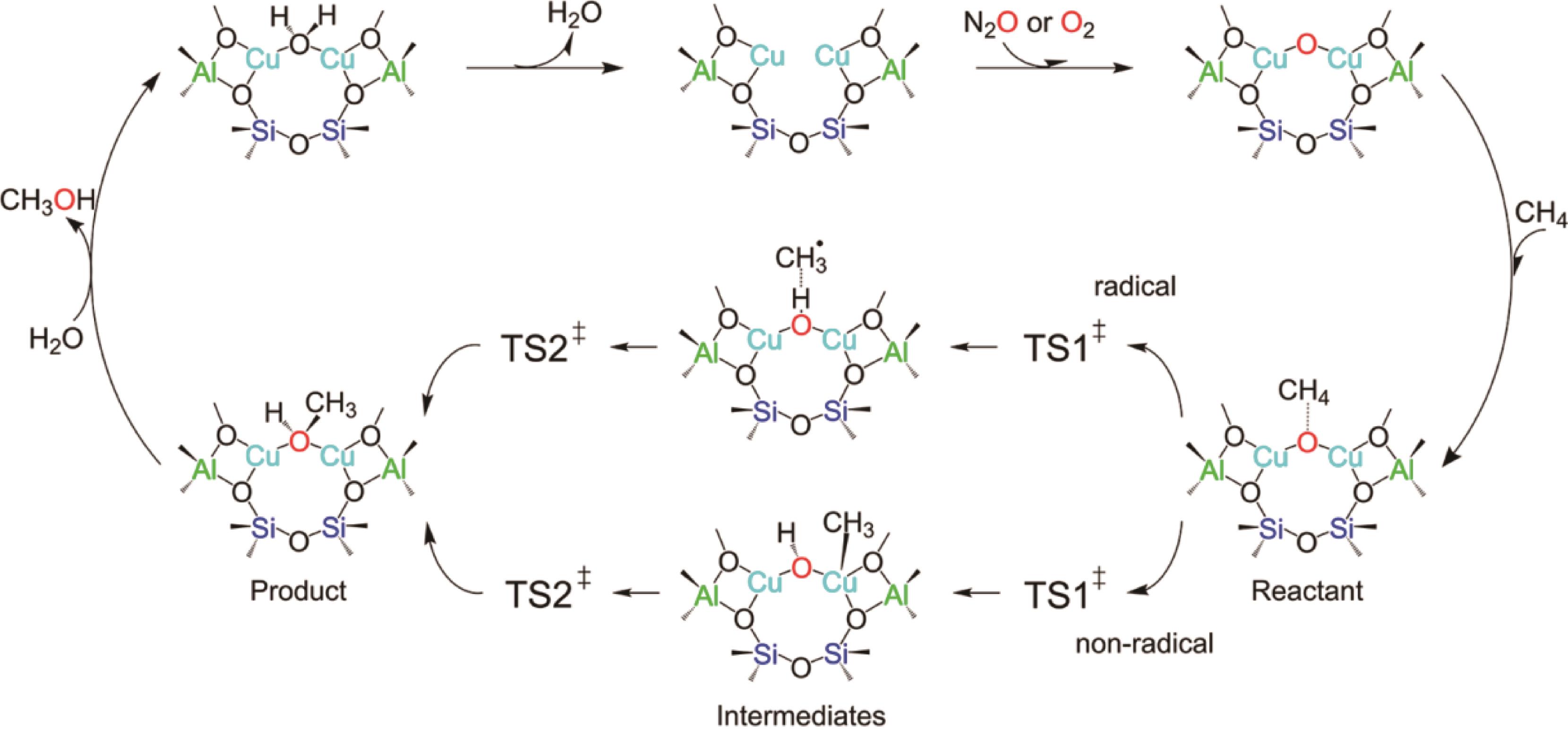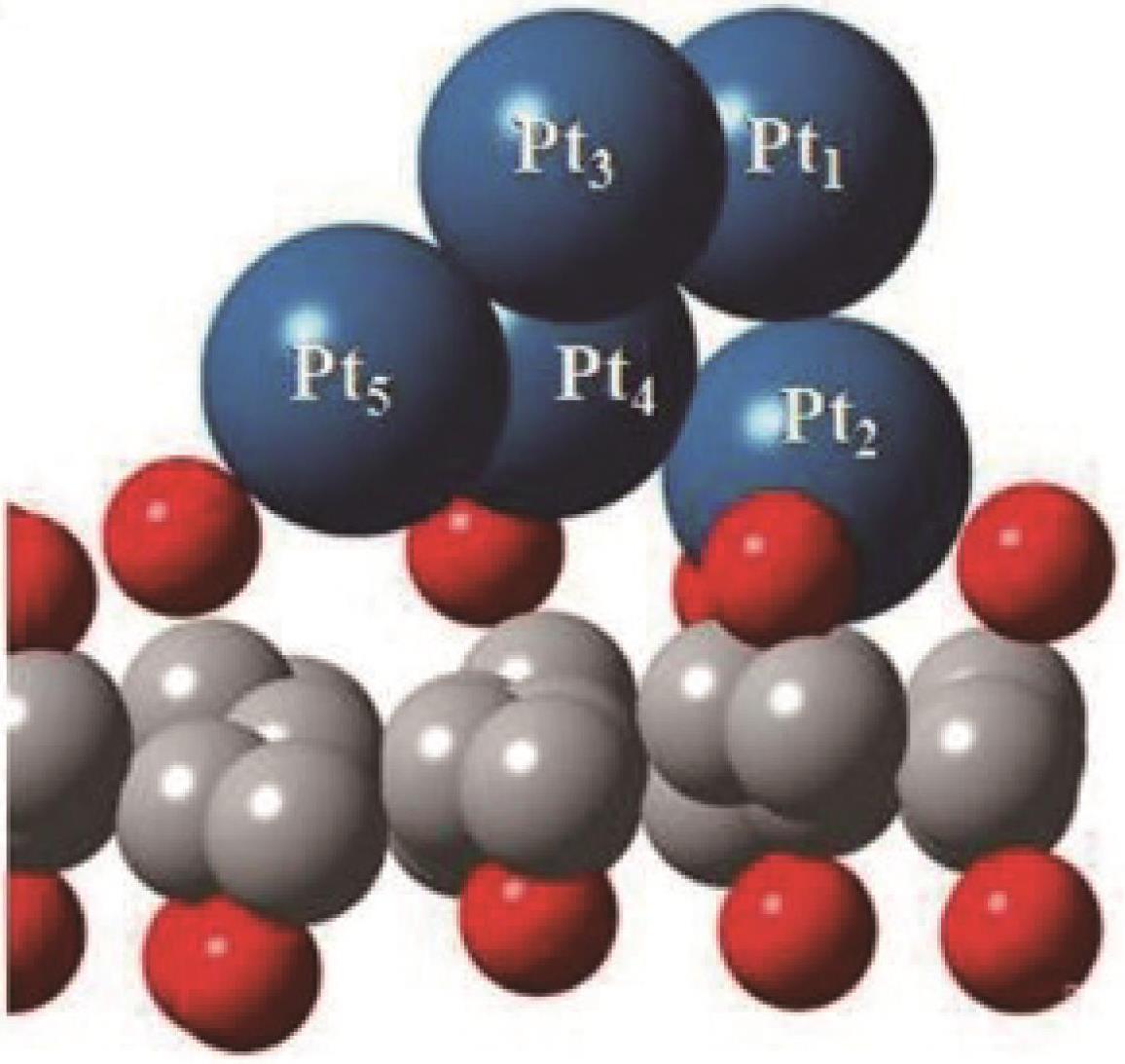
应用化学 ›› 2022, Vol. 39 ›› Issue (4): 540-558.DOI: 10.19894/j.issn.1000-0518.210461
甲烷直接催化氧化制备甲醇近期研究进展
- 中国科学院长春应用化学研究所,稀土资源利用国家重点实验室,长春 130022
-
收稿日期:2021-09-10接受日期:2021-12-10出版日期:2022-04-01发布日期:2022-04-19 -
通讯作者:汪啸 -
基金资助:国家自然科学基金(21771173);国家重点研发计划项目(2016YFA0203200)
Recent Advances in Direct Oxidation of Methane to Methanol
Ke WANG, Xiao WANG( ), Shu-Yan SONG
), Shu-Yan SONG
- State Key Laboratory of Rare Earth Resource Utilization,Changchun Institute of Applied Chemistry,Chinese Academy of Sciences,Changchun 130022,China
-
Received:2021-09-10Accepted:2021-12-10Published:2022-04-01Online:2022-04-19 -
Contact:Xiao WANG -
About author:skybyyn@ciac.ac.cn
-
Supported by:the National Natural Science Foundation of China(21771173);the National Key Research and Development Program of China(2016YFA0203200)
摘要:
甲烷合成甲醇的方法包括间接法和直接催化氧化(DMTM)法,但是间接法对设备要求高,且甲烷转化率与甲醇选择性均不理想,DMTM法可通过一步反应高选择性制备甲醇,有巨大的应用潜力。对于甲烷DMTM法合成甲醇,均相催化体系通常需要特殊反应介质与贵金属催化剂相结合,虽然反应效率高,但对反应设备有腐蚀性,产物不易分离,应用前景差。液相-异相催化一般使用H2O2作为氧化剂,Au、Pd、Fe和Cu等金属元素作为催化剂主要活性组分,·OH是主要的氧化活性物,可在低温下实现甲烷的活化氧化。因此,异相催化体系是目前研究的主流。气相-异相催化主要使用O2和N2O为氧化剂,前者氧化性更强,后者对于产品选择性更好,此外,厌氧体系中H2O也可直接作为氧供体,常用Cu、Fe、Rh等元素作为催化剂。沸石分子筛是使用最广泛的载体,金属氧化物、金属有机骨架化合物(MOFs)和石墨烯也均有涉及,多金属协同催化已经取得了很好的效果。本文主要总结与概述了热催化甲烷直接催化氧化制备甲醇的近年相关研究,并对今后的研究方向做出了展望。
中图分类号:
引用本文
王克, 汪啸, 宋术岩. 甲烷直接催化氧化制备甲醇近期研究进展[J]. 应用化学, 2022, 39(4): 540-558.
Ke WANG, Xiao WANG, Shu-Yan SONG. Recent Advances in Direct Oxidation of Methane to Methanol[J]. Chinese Journal of Applied Chemistry, 2022, 39(4): 540-558.
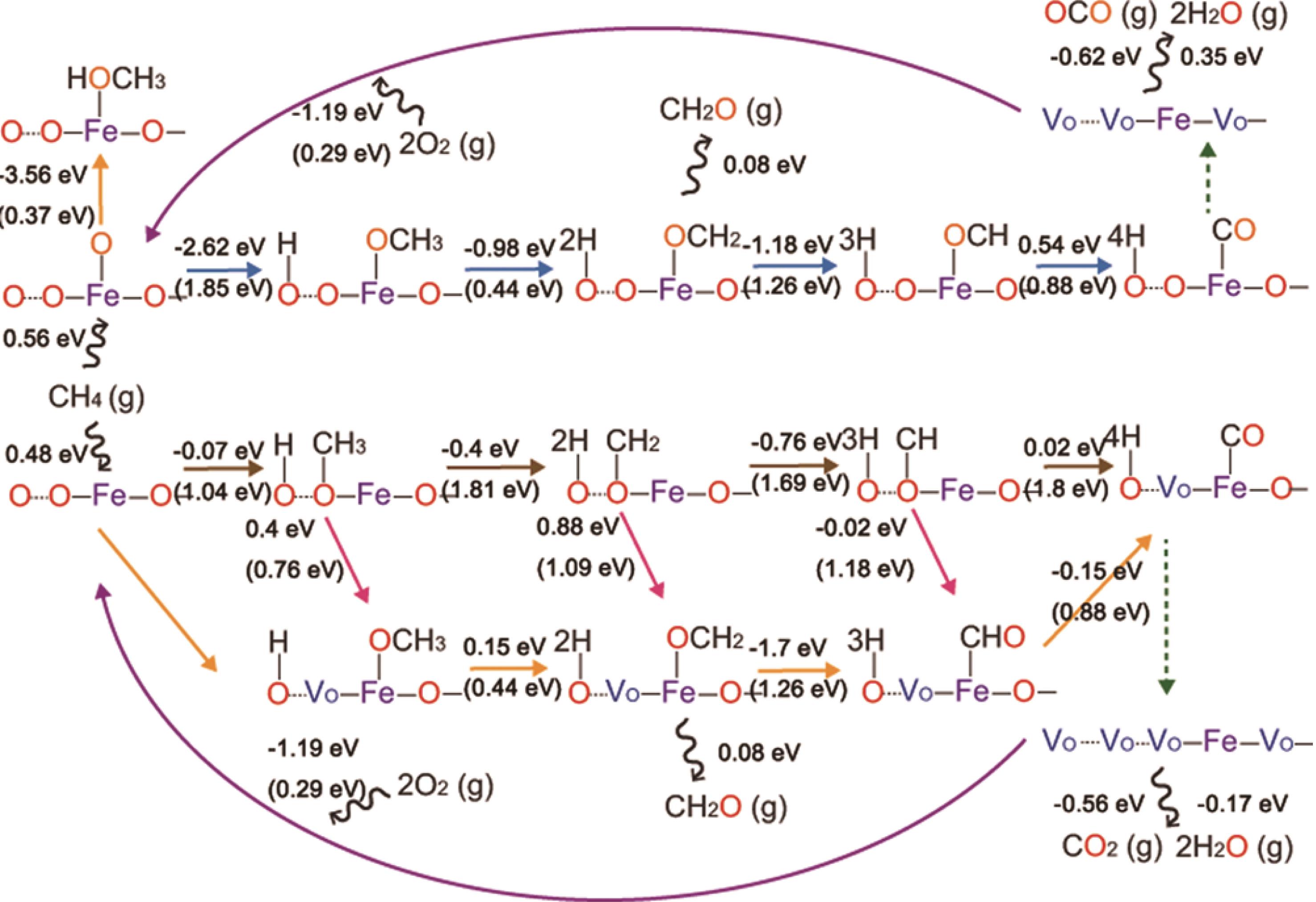
图10 Fe2O3(0001)面活化CH4计算能量网状图[45]黄色O:晶格O;红色O:铁基O;棕色箭头:CH4分解;黄色和蓝色箭头分别代表CH4在晶格O和铁基O的氧化分解;绿色虚线箭头表示CO2和H2O的形成;紫色箭头表示活性位点的再生;曲线箭头表示气相物种的吸附/解吸
Fig.10 Energy network diagram of Fe2O3 (0001) surface activation of CH4[45]Yellow O: lattice O; red O: iron-based O; brown arrows: CH4 decomposition; yellow and blue arrows represent the oxidative decomposition of CH4 in lattice O and iron-based O, respectively; green dotted arrows represent the formation of CO2 and H2O; The purple arrow indicates the regeneration of the active site; the curved arrow indicates the adsorption/desorption of gas phase species
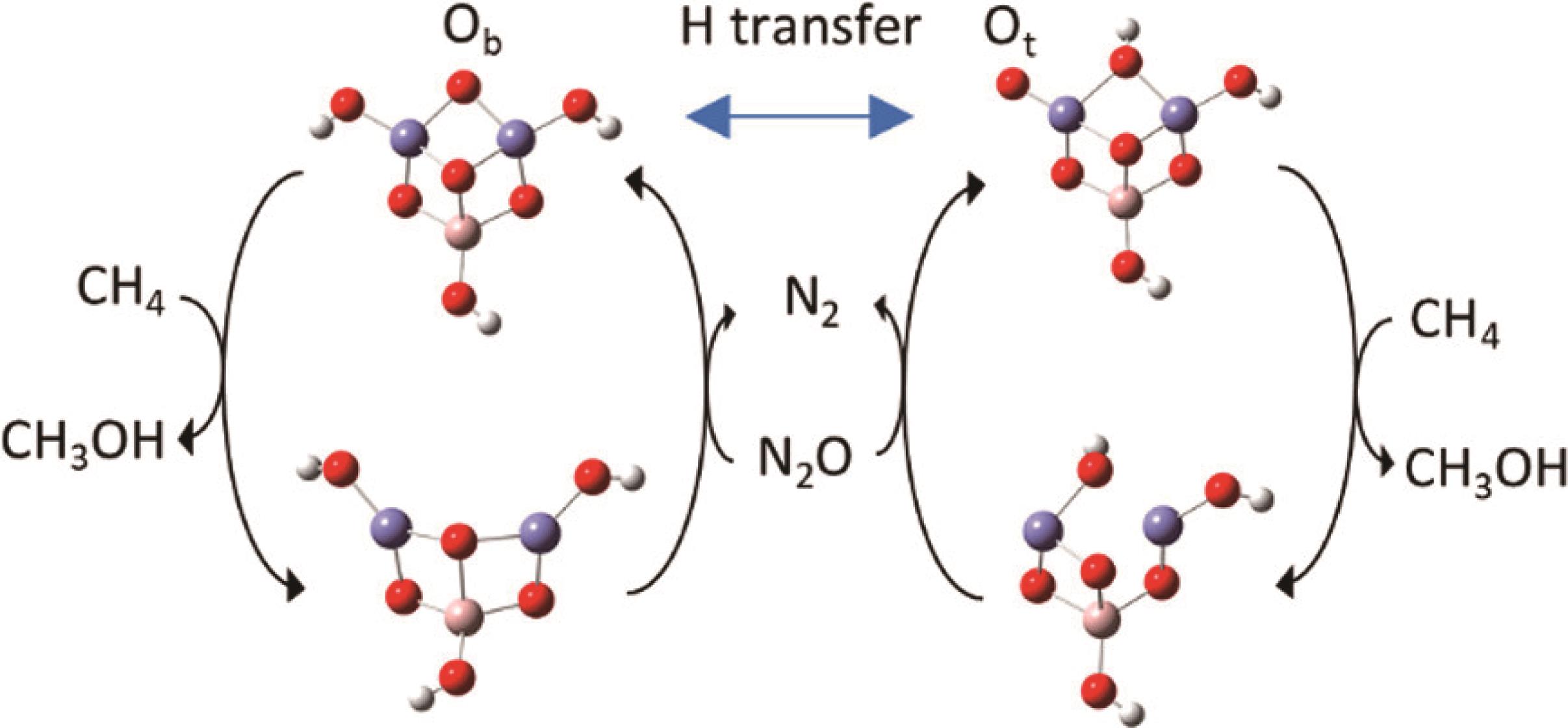
图11 N2O为氧化剂,Fe2O3纳米团簇催化CH4活化氧化制甲醇机理[46]
Fig.11 Mechanism of N2O as the oxidant and Fe2O3 nanoclusters catalyzing the activation and oxidation of CH4 to methanol[46]
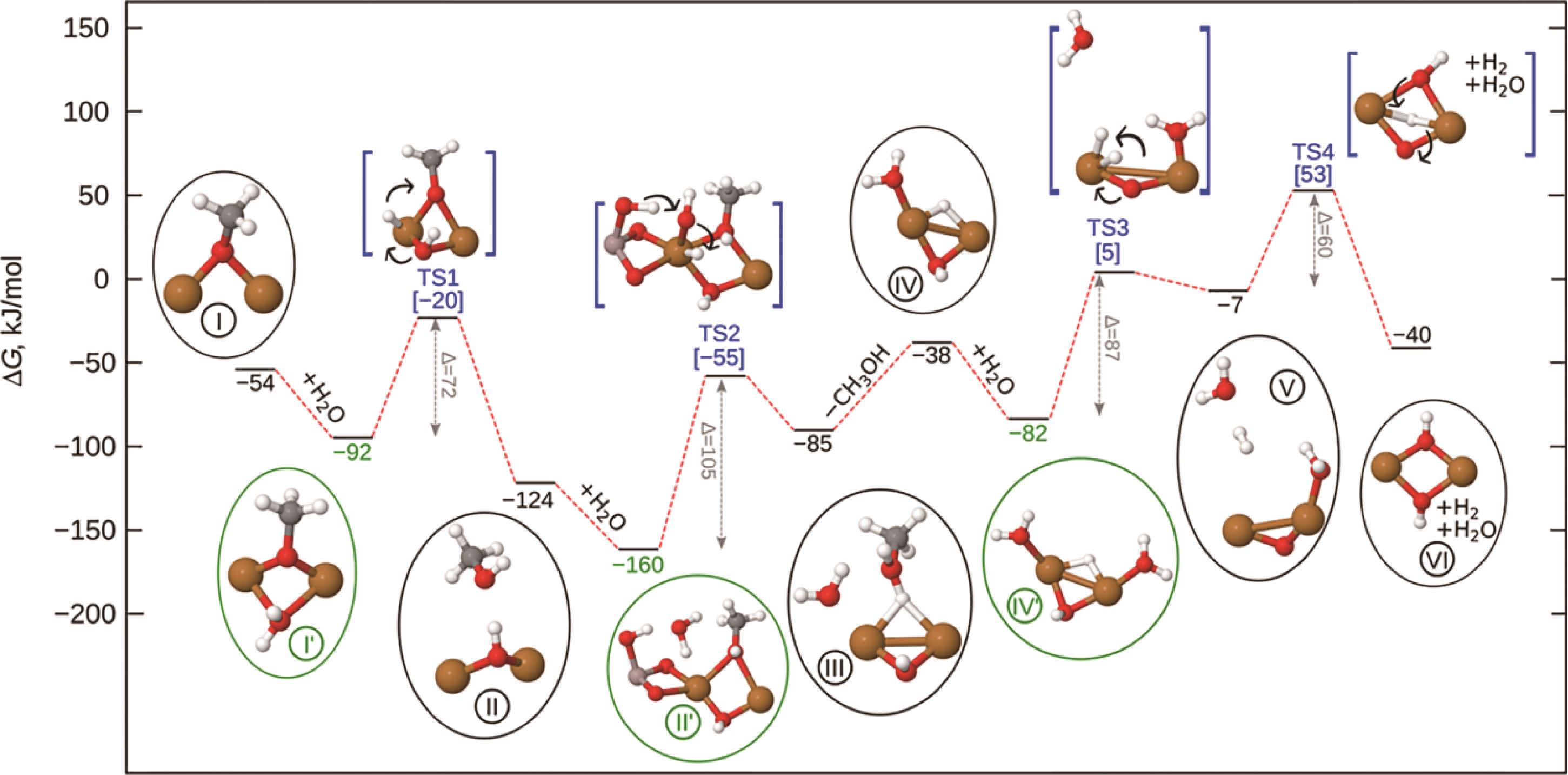
图13 双聚体Cu-沸石厌氧催化CH4生成CH3OH能量计算图(kJ/mol)[55]
Fig.13 Energy calculation diagram for the anaerobic catalysis of dimer Cu-zeolite from CH4 to CH3OH(kJ/mol)[55]
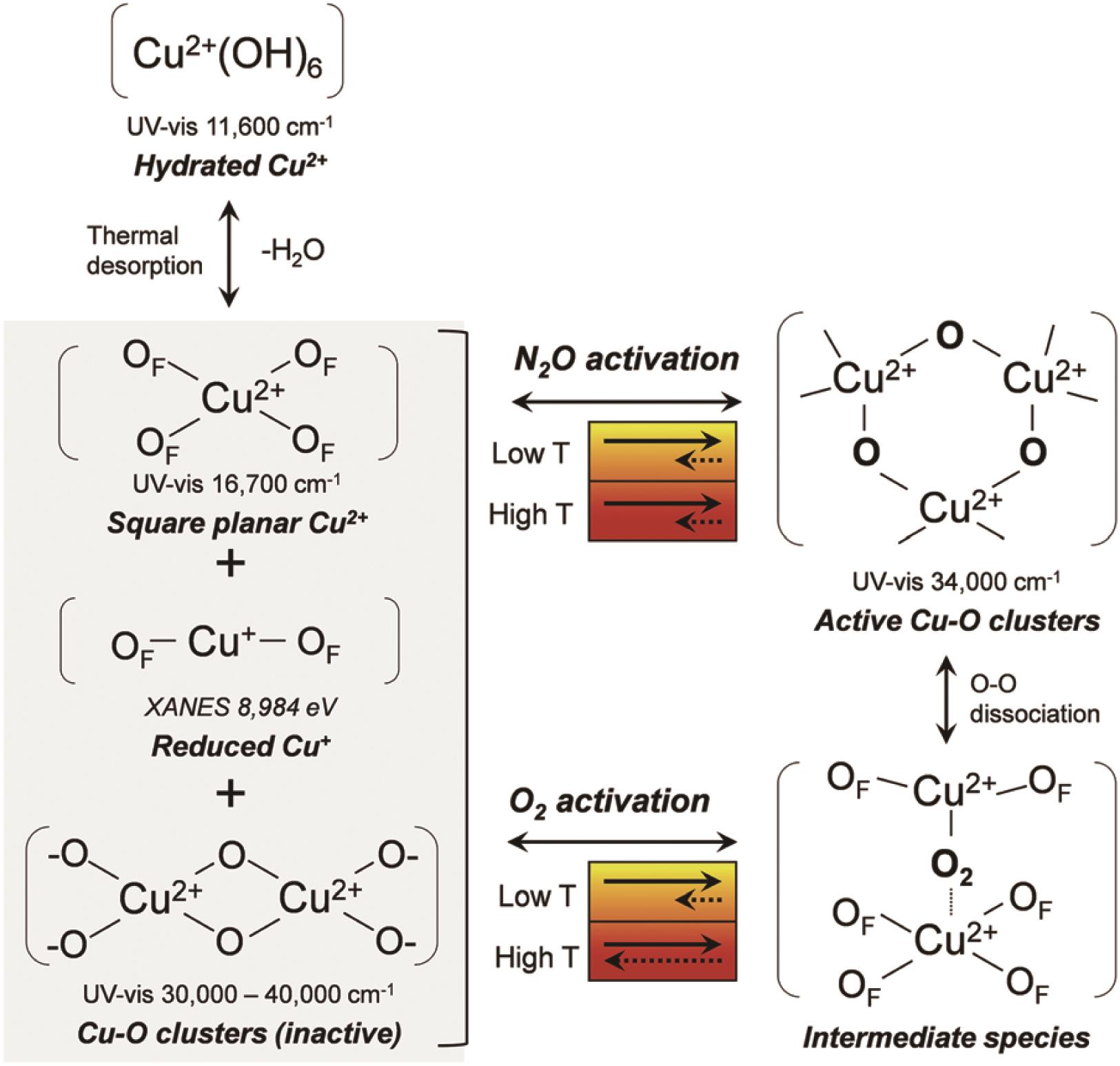
图14 N2O和O2活化过程中Cu物种的可能形成机制(OF为沸石骨架中的O原子)[7]
Fig.14 The possible formation mechanism of Cu species during the activation of N2O and O2 (OF is the O atom in the zeolite framework)[7]
催化剂 Catalyst | 组成 Composition | 氧化剂 Oxidant | 反应条件 Reaction conditions | 选择性 Selective | 转化率 Conversion | 产量/h Yields | 参考文献 Ref. |
|---|---|---|---|---|---|---|---|
| Cu?MAZ | n(Si)/n(Al)=4∶3 4.4%(mass fraction)Cu | O2 | 723 K,O2;473 K, | 150 μmol/gcat、 200 μmol/g TON=0.48 | [ | ||
Cu?MAZ (棒状) (rod) | n(Si)/n(Al)=4.32 4.64%(mass fraction)Cu | O2 | 723 K,O2;473 K, | 197 μmol/g | [ |
表1 近年Cu-沸石催化剂活化CH4制CH3OH性能总结
Table 1 Synthesis of CH3OH by Cu?zeolite catalyst activated CH4 in recent years
催化剂 Catalyst | 组成 Composition | 氧化剂 Oxidant | 反应条件 Reaction conditions | 选择性 Selective | 转化率 Conversion | 产量/h Yields | 参考文献 Ref. |
|---|---|---|---|---|---|---|---|
| Cu?MAZ | n(Si)/n(Al)=4∶3 4.4%(mass fraction)Cu | O2 | 723 K,O2;473 K, | 150 μmol/gcat、 200 μmol/g TON=0.48 | [ | ||
Cu?MAZ (棒状) (rod) | n(Si)/n(Al)=4.32 4.64%(mass fraction)Cu | O2 | 723 K,O2;473 K, | 197 μmol/g | [ |
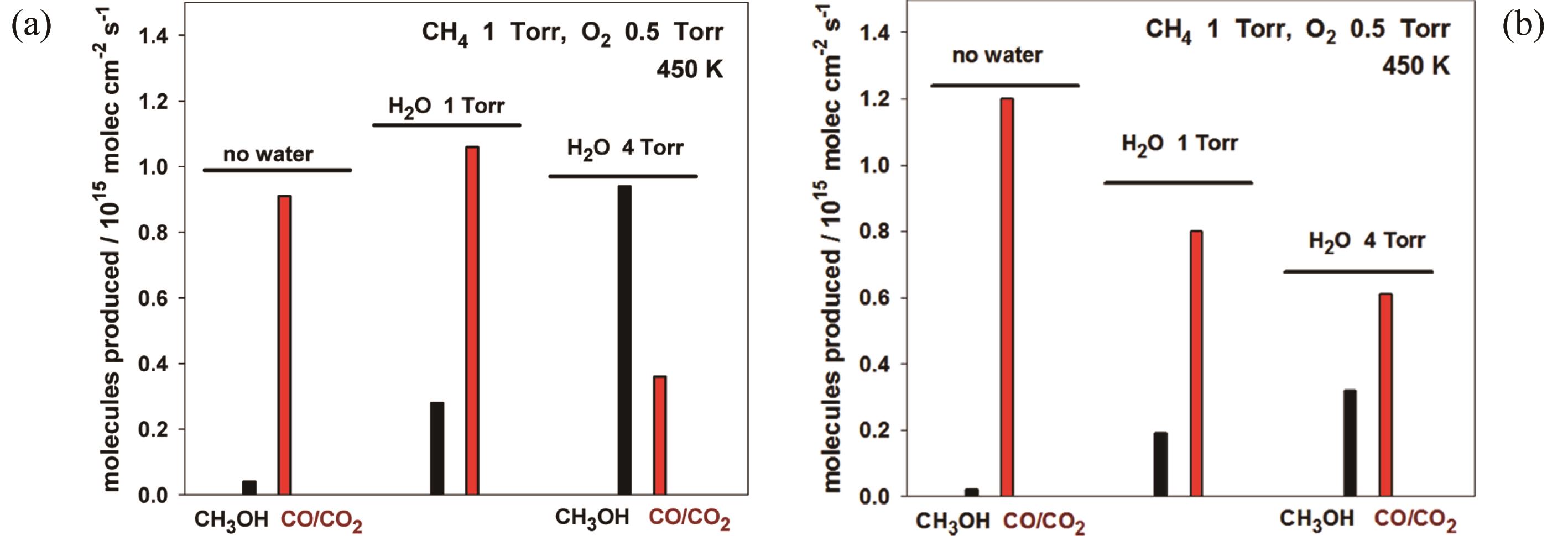
图16 水对催化剂催化CH4制CH3OH的产品选择性提升效果(a)CeO2/Cu2O/Cu(111)催化剂,CeO2覆盖率为0.4[81];(b)Ni/CeO2(111)催化剂,Ni覆盖率为0.15[83](T=450 K,pCH4=0.1 MPa,pO2=0.05 MPa)
Fig.16 The effect of water on the catalyst catalyzing the product selectivity improvement of CH4 to CH3OH (a) CeO2/Cu2O/Cu(111) catalyst,SAC=0.4[81];(b)Ni/CeO2(111) catalyst,SAC=0.15[83](T=450 K,pCH4=0.1 MPa,pO2=0.05 MPa)
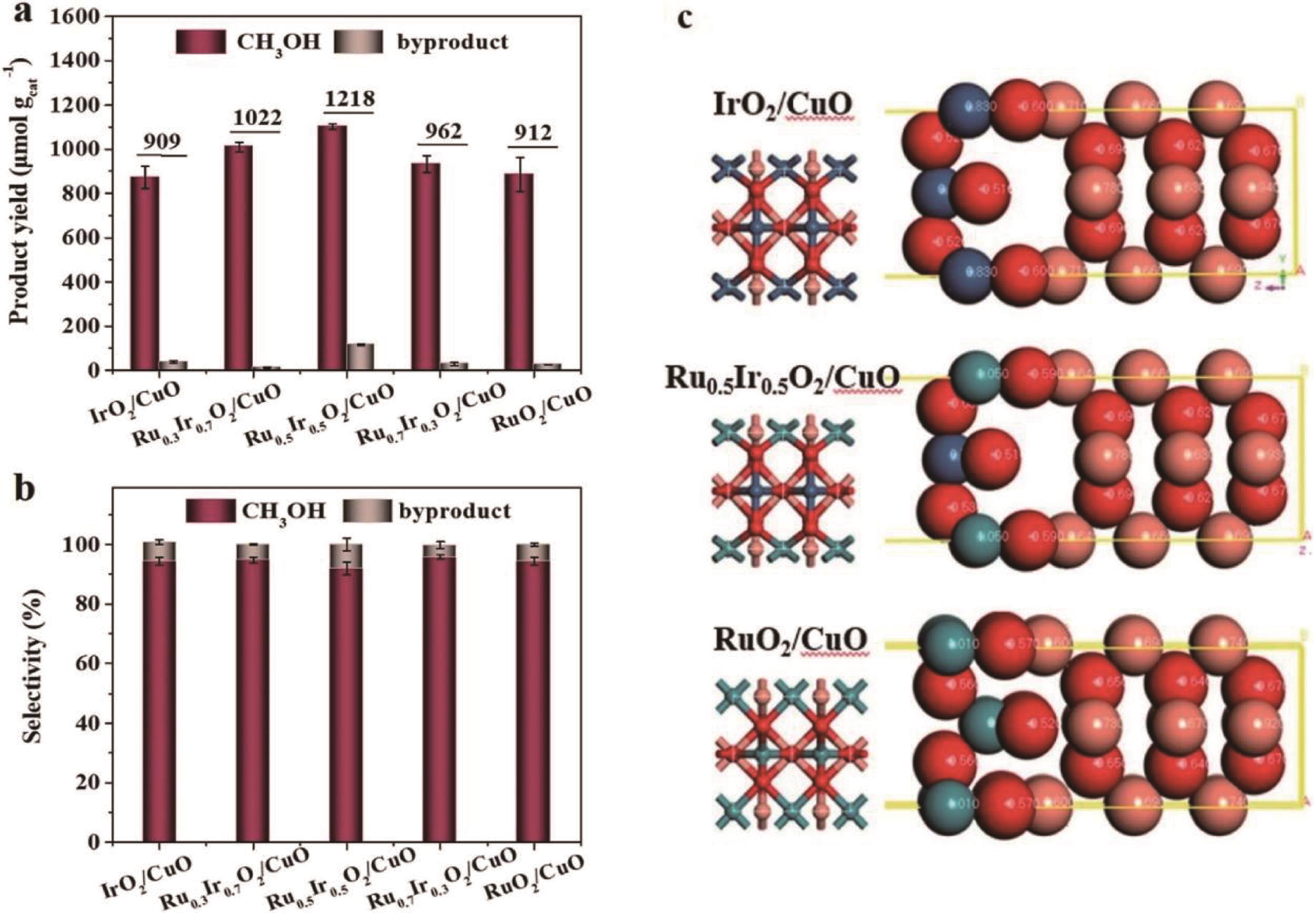
图17 Ru x Ir1-x /CuO催化剂催化效果及结构信息(a)CH3OH及副产物收率;(b)选择性;(c)电荷分析结构模型[85]
Fig.17 The catalytic effect and structure information of Ru x Ir1-x /CuO catalyst (a) CH3OH and by-product yield; (b) selectivity; (c) charge analysis structure model[85]
| 1 | YORK A P E, XIAO T C, GREEN M L H. Brief overview of the partial oxidation of methane to synthesis gas[J]. Top Catal, 2003, 22(3/4): 345-358. |
| 2 | VAN A A. Methane. a review[J]. J Environ Sci (China), 2012, 9(1): 5-30. |
| 3 | LIN C Y, ZHANG X W, FANG X C, et al. Advances in research on low-temperature activation of methane to methanol[J]. Chem Ind Eng Prog, 2012, 31(10): 2124-2129, 2161. |
| 4 | DA SILVA M J. Synthesis of methanol from methane: challenges and advances on the multi-step (syngas) and one-step routes (DMTM)[J]. Fuel Process Technol, 2016, 145: 42-61. |
| 5 | RAVI M, RANOCCGIARI M, VAN B J A. The direct catalytic oxidation of methane to methanol-a critical assessment[J]. Angew Chem Int Ed, 2017, 56(52): 16464-16483. |
| 6 | HAN B Z, YANG Y, XU Y Y, et al. A review of the direct oxidation of methane to methanol[J]. Chin J Catal, 2016, 37(8): 1206-1215. |
| 7 | KIM Y, KIM T Y, LEE H, et al. Distinct activation of Cu-MOR for direct oxidation of methane to methanol[J]. Chem Commun, 2017, 53(29): 4116-4119. |
| 8 | SUSHKEVICH V L, PALAGIN D, RANOCCHIARI M, et al. Selective anaerobic oxidation of methane enables direct synthesis of methanol[J]. Science, 2017, 356(6337): 523. |
| 9 | GELETII Y V, SHILOV A E. Catalytic-oxidation of alkanes by molecular oxidation-oxidation of methane in the presence of platinum salts and heteropoly acids[J]. Kinet Catal, 1983, 24: 413-416. |
| 10 | SEN A, GRETZ E, OLIVER T F, et al. Palladium(II) mediated oxidative functionalization of alkanes and arenes[J]. New J Chem, 1989, 13(10/11): 755-760. |
| 11 | PERIANA R A, TAUBE D J, EVITT E R, et al. A mercury-catalyzed, high-yield system for the oxidation of methane to methanol[J]. Science, 1993, 259(5093): 340-343. |
| 12 | PERIANA R A, TAUBE D J, GAMBLE S, et al. Platinum catalysts for the high-yield oxidation of methane to a methanol derivative[J]. Science, 1998, 280(5363): 560-564. |
| 13 | TIAN Y D, PIAO L Y, CHEN X B. Research progress on the photocatalytic activation of methane to methanol[J]. Green Chem, 2021, 23(10): 3526-3541. |
| 14 | BJERRUM N J, XIAO G, HJULER H A A G E. A process for the catalytic oxidation of hydrocabons[P]. European Patent Office Publ. of Application with search report EP19980954247. 11 Nov 1998. |
| 15 | 陈立宇, 杨伯伦, 张秀成, 等. 甲烷液相部分氧化合成甲醇过程研究[J]. 高校化学工程学报, 2005, 19(1): 54-58. |
| CHEN L Y, YANG B L, ZHANG X C, et al. Study of catalysis oxidation of methane to methanol in liquid phase[J]. J Chem Eng Chin Univ, 2005, 19(1): 54-58. | |
| 16 | XU F, WU Y, LI C, et al. Mechanism study of Pd(OAc)2-catalyzed selective oxidation of methane to methanol in acetic acid solution[J]. Nat Gas Chem Ind, 2016, 41(1): 33-36. |
| 17 | LIU Y F, DU L K. Theoretical study of the oxidation of methane to methanol by the (CuCuII)-Cu-II(mu-O)(2)Cu-III(7-N-Etppaz) (1+) complex[J]. Inorg Chem, 2018, 57(6): 3261-3271. |
| 18 | ZHANG L, SUN Z X, LANG J Y, et al. Direct conversion of methane to oxygenates catalyzed by iron(III) chloride in water at near ambient temperature[J]. Int J Energy Res, 2021, 45(2): 2581-2592. |
| 19 | OHKUBO K, HIROSE K. Light-driven C-H oxygenation of methane into methanol and formic acid by molecular oxygen using a perfluorinated solvent[J]. Angew Chem Int Ed, 2018, 57(8): 2126-2129. |
| 20 | AYODELE O B. Structure and reactivity of ZSM-5 Supported oxalate ligand functionalized nano-Fe catalyst for low temperature direct methane conversion to methanol[J]. Energy Convers Manage, 2016, 126: 537-547. |
| 21 | SZECSENYI A, LI G N, GASCON J, et al. Mechanistic complexity of methane oxidation with H2O2 by single-site Fe/ZSM-5 catalyst[J]. ACS Catal, 2018, 8(9): 7961-7972. |
| 22 | OSADCHII D Y, OLIVOS-SUAREZ A I, SZECSENYI A, et al. Isolated Fe sites in metal organic frameworks catalyze the direct conversion of methane to methanol[J]. ACS Catal, 2018, 8(6): 5542-5548. |
| 23 | XIAO P P, WANG Y, NISHITOBA T, et al. Selective oxidation of methane to methanol with H2O2 over an Fe-MFI Zeolite catalyst using sulfolane solvent[J]. Chem Commun, 2019, 55(20): 2896-2899. |
| 24 | SHAVI R, HIREMATH V, SEO J G. Radical-initiated oxidative conversion of methane to methanol over metallic iron and copper catalysts[J]. Mol Catal, 2018, 445: 232-239. |
| 25 | LIU C C, MOU C Y, YU S S F, et al. Heterogeneous formulation of the tricopper complex for efficient catalytic conversion of methane into methanol at ambient temperature and pressure[J]. Energy Environ Sci, 2016, 9(4): 1361-1374. |
| 26 | BOKARE A D, CHOI W Y. Review of iron-free Fenton-like systems for activating H2O2 in advanced oxidation processes[J]. J Hazard Mater, 2014, 275: 121-135. |
| 27 | KWON Y, KIM T Y, KWON G, et al. Selective activation of methane on single-atom catalyst of rhodium dispersed on zirconia for direct conversion[J]. J Am Chem Soc, 2017, 139(48): 17694-17699. |
| 28 | TANG Y, LI Y T, FUNG V, et al. Single rhodium atoms anchored in micropores for efficient transformation of methane under mild conditions[J]. Nat Commun, 2018, 9(1): 1-11. |
| 29 | ZHAO Q, LIU B, XU Y B, et al. Insight into the active site and reaction mechanism for selective oxidation of methane to methanol using H2O2 on a Rh-1/ZrO2 catalyst[J]. New J Chem, 2020, 44(4): 1632-1639. |
| 30 | SERRA M R, MICHEL F M, KANG Y J, et al. Decomposition of hydrogen peroxide catalyzed by AuPd nanocatalysts during methane oxidation to methanol[J]. ACS Catal, 2020, 10(9): 5115-5123. |
| 31 | SAJITH P K, STAYKOV A, YOSHIDA M, et al. Theoretical study of the direct conversion of methane to methanol using H2O2 as an oxidant on Pd and Au/Pd surfaces[J]. J Phys Chem C, 2020, 124(24): 13231-13239. |
| 32 | AGARWAL N, FREAKLEY S J, MC VICKER REBECCA U, et al. Aqueous Au-Pd colloids catalyze selective CH4 oxidation to CH3OH with O2 under mild conditions[J]. Science, 2017, 358(6360): 223-226. |
| 33 | YAN Y, CHEN C L, ZOU S H, et al. High H2O2 utilization promotes selective oxidation of methane to methanol at low temperature[J]. Front Chem, 2020, 8: 252. |
| 34 | AB RAHIM M H, FORDE M M, HAMMONDa C, et al. Systematic study of the oxidation of methane using supported gold palladium nanoparticles under mild aqueous conditions[J]. Top Catal, 2013, 56(18/20): 1843-1857. |
| 35 | WILLIAMS C, CARTER J H, DUMMER N F, et al. Selective oxidation of methane to methanol using supported AuPd catalysts prepared by stabilizer-free sol-immobilization[J]. ACS Catal, 2018, 8(3): 2567-2576. |
| 36 | AB RAHIM M H, ARMSTRONG R D, HAMMOND C, et al. Low Temperature selective oxidation of methane to methanol using titania supported gold palladium copper catalysts[J]. Catal Sci Technol, 2016, 6(10): 3410-3418. |
| 37 | HUANG W X, ZHANG S R, TANG Y, et al. Low-temperature transformation of methane to methanol on Pd1O4 single sites anchored on the internal surface of microporous silicate[J]. Angew Chem Int Ed, 2016, 55(43): 13441-13445. |
| 38 | LEWIS R J, BARA-ESTAUN A, AGARWAL N, et al. The direct synthesis of H2O2 and selective oxidation of methane to methanol using HZSM-5 supported AuPd catalysts[J]. Catal Lett, 2019, 149(11): 3066-3075. |
| 39 | HAMMOND CERI, JENKINS R L, DIMITRATOS N, et al. Catalytic and mechanistic insights of the low-temperature selective oxidation of methane over Cu-promoted Fe-ZSM-5[J]. Chem-Eur J, 2012, 18(49): 15735-15745. |
| 40 | XU J, ARMSTRONG R D, SHAW G, et al. Continuous selective oxidation of methane to methanol over Cu- and Fe-modified ZSM-5 catalysts in a flow reactor[J]. Catal Today, 2016, 270: 93-100. |
| 41 | FANG Z H, MURAYAMA H, ZHAO Q, et al. Selective mild oxidation of methane to methanol or formic acid on Fe-MOR catalysts[J]. Catal Sci Technol, 2019, 9(24): 6946-6956. |
| 42 | BAI S,XU Y, WANG P, et al. Activating and converting CH4 into CH3OH via CuPdO2/CuO nanointerface[J]. ACS Catal, 2019, 8(9): 6938-6944. |
| 43 | GERMAN E D, SHEINTUCH M. Predicting CH4 dissociation kinetics on metals: trends, sticking coefficients, H tunneling, and kinetic isotope effect[J]. J Phys Chem C, 2013, 117(44): 22811-22826. |
| 44 | BAI S X, YAO Q, XU Y, et al. Strong synergy in a lichen-like RuCu nanosheet boosts the direct methane oxidation to methanol[J]. Nano Energy, 2020, 71: 104566. |
| 45 | TANG J J, LIU B. Reactivity of the Fe2O3(0001) surface for methane oxidation: a GGA plus U study[J]. J Phys Chem C, 2016, 120(12): 6642-6650. |
| 46 | BARONA M, GAGGIOLI C A, GAGLIARDI L, et al. DFT study on the catalytic activity of ALD-grown diiron oxide nanoclusters for partial oxidation of methane to methanol[J]. J Phys Chem A, 2020, 124(8): 1580-1592. |
| 47 | HALL J N, BOLLINI P. Low-temperature, ambient pressure oxidation of methane to methanol over every tri-iron node in a metal-organic framework material[J]. Chem-Eur J, 2020, 26(70): 16639-16643. |
| 48 | DASIREDDY V D B C, HANZRL D, BHARUTH R K, et al. The effect of oxidant species on direct, non-syngas conversion of methane to methanol over an FePO4 catalyst material[J]. RSC Adv, 2019, 9(53): 30989-31003. |
| 49 | ROONGCHAROEN T, IMOPENG S, KUNGWAN N, et al. Revealing the effect of N-content in Fe doped graphene on its catalytic performance for direct oxidation of methane to methanol[J]. Appl Surf Sci, 2020, 527: 146833. |
| 50 | IMYEN T, ZNOUTINE E, SUTTIPAT D, et al. Methane utilization to methanol by a hybrid zeolite@metal-organic framework[J]. ACS Appl Mater Interfaces, 2020, 12(21): 23812-23821. |
| 51 | SHIOTA Y, YOSHIZAWA K. Methane-to-methanol conversion by first-row transition-metal oxide ions: ScO+, TiO+, VO+, CrO+, MnO+, FeO+, CoO+, NiO+, and CuO+[J]. J Am Chem Soc, 2000, 122(49): 12317-12326. |
| 52 | SHIOTA Y, JUHASZ G, YOSHIZAWA K. Role of Tyrosine residue in methane activation at the dicopper site of particulate methane monooxygenase: a density functional theory study[J]. Inorg Chem, 2013, 52(14): 7907-7917. |
| 53 | LI G N, VASSILEV P, SANCHEZ S M, et al. Stability and reactivity of copper oxo-clusters in ZSM-5 zeolite for selective methane oxidation to methanol[J]. J Catal, 2016, 338: 305-312. |
| 54 | MAHYUDDIN M H, SHIOTA Y, STAYKOV A, et al. Theoretical overview of methane hydroxylation by copper-oxygen species in enzymatic and zeolitic catalysts[J]. Acc Chem Res, 2018, 51(10): 2382-2390. |
| 55 | PALAGIN D, SUSHKEVICH V L, VAN BOKHOVEN J A. Water molecules facilitate hydrogen release in anaerobic oxidation of methane to methanol over Cu/mordenite[J]. ACS Catal, 2019, 9(11): 10365-10374. |
| 56 | MA C, TAN X J, ZHANG H J, et al. Direct conversion of methane to methanol over Cu exchanged mordenite: effect of counter ions[J]. Chin Chem Lett, 2020, 31(1): 235-238. |
| 57 | SUSHKEVICH V L, PALAGIN D, VAN BOKHOVEN J A. The effect of the active-site structure on the activity of copper mordenite in the aerobic and anaerobic conversion of methane into methanol[J]. Angew Chem Int Ed, 2018, 57(29): 8906-8910. |
| 58 | MEYET J, SEARLES K, NEWTON M A, et al. Monomeric copper(II) sites supported on alumina selectively convert methane to methanol[J]. Angew Chem Int Ed, 2019, 58(29): 9841-9845. |
| 59 | IKUNO T, ZHENG J, VJUNOV A, et al. Methane oxidation to methanol catalyzed by Cu-oxo clusters stabilized in NU-1000 metal-organic framework[J]. J Am Chem Soc, 2017, 139(30): 10294-10301. |
| 60 | LE HA V, PARISHAN S, SAGALTCHIK A, et al. Stepwise methane-to-methanol conversion on CuO/SBA-15[J]. Chem - Eur J, 2018, 24(48): 12592-12599. |
| 61 | WANG X T, SHISHKIN A, HEMMINGSSON F, et al. Methane adsorption and methanol desorption of copper modified boron silicate[J]. RSC Adv, 2018, 8(63): 36369-36374. |
| 62 | KVANDE K, PAPPAS D K., DYBALLAy M, et al. Comparing the nature of active sites in Cu-loaded SAPO-34 and SSZ-13 for the direct conversion of methane to methanol[J]. Catalysts, 2020, 10(2): 191. |
| 63 | KNORPP A J, PINAR A B, NEWTON M A, et al. Copper-exchanged omega (MAZ) zeolite: copper-concentration dependent active sites and its unprecedented methane to methanol conversion[J]. ChemCatChem, 2018, 10(24): 5593-5596. |
| 64 | KNORPP A J, NEWTON M A, SUSHKEVICH V L, et al. The influence of zeolite morphology on the conversion of methane to methanol on copper-exchanged omega zeolite (MAZ)[J]. Catal Sci Technol, 2019, 9: 2806-2811. |
| 65 | KNORPP A J, NEWTON M A, MIZUNO S C M, et al. Comparative performance of Cu-zeolites in the isothermal conversion of methane to methanol[J]. Chem Commun, 2019, 55(78): 11794-11797. |
| 66 | TOMKINS P, MANSOURI A, BOZBAG S E, et al. Isothermal cyclic conversion of methane into methanol over copper-exchanged zeolite at low temperature[J]. Angew Chem Int Ed, 2016, 55(18): 5467-5471. |
| 67 | ZENG R, LI L Y, SHIMIZU T, et al. Direct conversion of methane to methanol over copper-exchanged zeolite under mild conditions[J]. J Energy Eng, 2020, 146(6): 04020061. |
| 68 | NARSIMHAN K, IYOKI K, DINH K, et al. Catalytic oxidation of methane into methanol over copper-exchanged zeolites with oxygen at low temperature[J]. ACS Cent Sci, 2016, 2(6): 424-429. |
| 69 | PAPPAS D K, BORFECCHIA E, DYBALLA M, et al. Methane to methanol: structure activity relationships for Cu-CHA[J]. J Am Chem Soc, 2017, 139(42): 14961-14975. |
| 70 | IPEK B, LOBO R F. Catalytic conversion of methane to methanol on Cu-SSZ-13 using N2O as oxidant[J]. Chem Commun, 2016, 52(91): 13401-13404. |
| 71 | MEMIOGLU O, IPEK B. A potential catalyst for continuous methane partial oxidation to methanol using N2O: Cu-SSZ-39[J]. Chem Commun, 2021, 57(11): 1364-1367. |
| 72 | KOISHYBAY A, SHANTZ D F. Water is the oxygen source for methanol produced in partial oxidation of methane in a flow reactor over Cu-SSZ-13[J]. J Am Chem Soc, 2020, 142(28): 11962-11966. |
| 73 | ZHU J, SUSHKEVICH V L, KNORPP A J, et al. Cu-erionite zeolite achieves high yield in direct oxidation of methane to methanol by isothermal chemical looping[J]. Chem Mater, 2020, 32(4): 1448-1453. |
| 74 | BUNTING R J, THOMPSON J, HU P. The mechanism and ligand effects of single atom rhodium supported on ZSM-5 for the selective oxidation of methane to methanol[J]. Phys Chem Chem Phys, 2020, 22(20): 11686-11694. |
| 75 | MAHYUDDIN M H, TANAKA S, SHIOTA Y, et al. Room-temperature activation of methane and direct formations of acetic acid and methanol on Zn-ZSM-5 zeolite: a mechanistic DFT study[J]. Bull Chem Soc Jpn, 2020, 93(3): 345-354. |
| 76 | NEEMATOLLAHI P, NEYTS E C. Direct oxidation of methane to methanol on Co embedded N-doped graphene: comparing the role of N2O and O2 as oxidants[J]. Appl Catal A, 2020, 602: 04020061. |
| 77 | YUAN J Y, ZHANG W H, LI X X, et al. A high performance catalyst for methane conversion to methanol: graphene supported single atom Co[J]. Chem Commun, 2018, 54(18): 2284-2287. |
| 78 | MOUSAVIAN P, ESRAFILI M D. Methane oxidation into methanol catalyzed by TM-snchored C24N24 nanoclusters (TM = Fe, Co and Ni): a DFT study[J]. Inorg Chem Commun, 2020, 122: 108317. |
| 79 | CHANG C C, LIU C Y, SUN Y C. Effective methane conversion to methanol on Bi-functional graphene-oxide-supported platinum nanoclusters (Pt-5)-a DFT study[J]. Phys Chem Chem Phys, 2020, 122: 4967-4973. |
| 80 | ZUO Z J, RAMIREZ P J, SENANAYAKE S D, et al. Low-temperature conversion of methane to methanol on CeOx/Cu2O catalysts: water controlled activation of the C—H bond[J]. J Am Chem Soc, 2016, 138(42): 13810-13813. |
| 81 | LIU Z Y, HUANG E W, OROZCO I, et al. Water-promoted interfacial pathways in methane oxidation to methanol on a CeO2-Cu2O catalyst[J]. Science, 2020, 368(6490): 513-517. |
| 82 | KYE S H, PARK H S, ZHANG R Q, et al. Partial oxidation of methane to methanol by isolated Pt catalyst supported on a CeO2 nanoparticle[J]. J Chem Phys, 2020, 152(5): 054715. |
| 83 | LUSTEMBERG P G, PALOMINO R M, GUTIERREZ R A, et al. Direct conversion of methane to methanol on Ni-ceria surfaces: metal-support interactions and water-enabled catalytic conversion by site blocking[J]. J Am Chem Soc, 2018, 140(24): 7681-7687. |
| 84 | YANG L, HUANG J X, MA R, et al. Metal-organic framework-derived IrO2/CuO catalyst for selective oxidation of methane to methanol[J]. ACS Energy Lett, 2019, 4(12): 2945-2951. |
| 85 | YANG L, HUANG J X, DAI S, et al. Uniphase ruthenium-iridium alloy-based electronic regulation for electronic structure-function study in methane oxidation to methanol[J]. J Mater Chem A, 2020, 8(45): 24024-24030. |
| 86 | BARONA M, SNURR R Q. Exploring the Tunability of trimetallic MOF nodes for partial oxidation of methane to methanol[J]. ACS Appl Mater Interfaces, 2020, 12(25): 28217-28231. |
| 87 | TOMKINS P, MANSOURI A, SUSHKEVICH V L, et al. Increasing the activity of copper exchanged mordenite in the direct isothermal conversion of methane to methanol by Pt and Pd doping[J]. Chem Sci, 2019, 10(1): 167-171. |
| [1] | 张毅城, 查飞, 唐小华, 常玥, 田海锋, 郭效军. 非均相催化制备有机过氧化物的研究进展[J]. 应用化学, 2023, 40(6): 769-788. |
| [2] | 熊兴泉, 张辉, 高利柱. 木质素的功能化与应用研究进展[J]. 应用化学, 2023, 40(6): 806-819. |
| [3] | 刘也, 郭少波, 梁艳莉, 葛红光, 马剑琪, 刘智峰, 刘波. 核壳型纳米复合材料CuFe2O4@NH2@Pt的制备及催化性能[J]. 应用化学, 2022, 39(8): 1237-1245. |
| [4] | 孙志聪, 孟庆磊, 马荣鹏, 葛君杰, 刘长鹏, 邢巍. 功能化氮化碳对Pd基甲酸分解制氢催化剂性能的促进作用[J]. 应用化学, 2020, 37(10): 1187-1194. |
| [5] | 朱晨阳, 罗志雄, 陈宬, Chaemchuen Somboon, Verpoort Francis. 沸石咪唑酯骨架-67高效催化L-丙交酯的开环聚合反应[J]. 应用化学, 2019, 36(4): 414-422. |
| [6] | 朱晨阳, 罗志雄, 陈宬, Chaemchuen Somboon, Verpoort Francis. 沸石咪唑酯骨架-67高效催化L-丙交酯的开环聚合反应[J]. 应用化学, 2019, 36(4): 0-0. |
| [7] | 董婷婷, 毕丛丛, 高保娇. 交联聚苯乙烯微球固载2,2,6,6-四甲基哌啶氮氧自由基的催化氧化性能与机理[J]. 应用化学, 2016, 33(9): 1017-1025. |
| [8] | 许波,孙延杰,杜飞瀑,蔡正国. 桥联环戊二烯金刚烷氨基二甲基钛配合物的合成及其催化丙烯聚合[J]. 应用化学, 2015, 32(9): 1028-1032. |
| [9] | 肖立伟, 高红杰, 任丽磊, 康健. 改性活性炭负载氯化铁催化氧杂蒽衍生物的合成[J]. 应用化学, 2015, 32(3): 304-309. |
| [10] | 伏振宇, 李志光, 郭开, 夏兴良, 彭海军, 何纯莲. 印染污泥的活性炭负载过渡金属化合物非均相催化臭氧化[J]. 应用化学, 2013, 30(10): 1169-1175. |
| [11] | 秦高飞, 周莹, 罗芩, 蒋文伟, 王吉德, 杨琴. 液相废催化剂中铂的硫脲萃取回收工艺及应用[J]. 应用化学, 2011, 28(11): 1337-1339. |
| [12] | 范荫恒, 武美霞, 侯瑞, 廖世健. 茂钛配合物/纳米氢化钠高活性加氢催化剂活性物种相态[J]. 应用化学, 2009, 26(3): 349-351. |
| [13] | 张玉良, 钱明星, 何仁. 过渡金属络合物催化乙烯齐聚[J]. 应用化学, 2001, 18(5): 360-364. |
| [14] | 蔡小平, 龚志, 王佛松, 朱行洁, 李秀华. Nd(i-PrO)2Cl-AlEt3均相二元催化剂异戊二烯聚合动力学──Ⅲ.AlEt3的链转移作用[J]. 应用化学, 1996, 0(6): 81-83. |
| [15] | 朱道亚, 吕俊民. 有机铝化合物的结构对丙烯齐聚均相催化剂性能的影响[J]. 应用化学, 1990, 0(3): 66-68. |
| 阅读次数 | ||||||
|
全文 |
|
|||||
|
摘要 |
|
|||||
